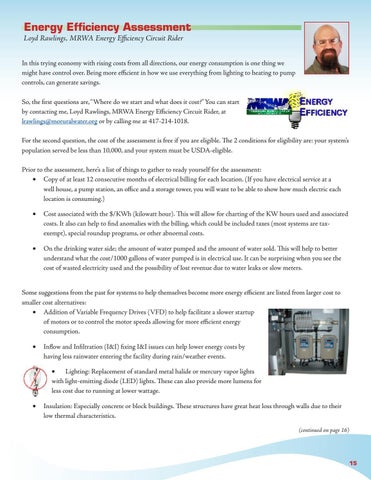Energy Efficiency Assessment Loyd Rawlings, MRWA Energy Efficiency Circuit Rider In this trying economy with rising costs from all directions, our energy consumption is one thing we might have control over. Being more efficient in how we use everything from lighting to heating to pump controls, can generate savings. So, the first questions are, “Where do we start and what does it cost?” You can start by contacting me, Loyd Rawlings, MRWA Energy Efficiency Circuit Rider, at lrawlings@moruralwater.org or by calling me at 417-214-1018. For the second question, the cost of the assessment is free if you are eligible. The 2 conditions for eligibility are: your system’s population served be less than 10,000, and your system must be USDA-eligible. Prior to the assessment, here’s a list of things to gather to ready yourself for the assessment: • Copy of at least 12 consecutive months of electrical billing for each location. (If you have electrical service at a well house, a pump station, an office and a storage tower, you will want to be able to show how much electric each location is consuming.) • Cost associated with the $/KWh (kilowatt hour). This will allow for charting of the KW hours used and associated costs. It also can help to find anomalies with the billing, which could be included taxes (most systems are taxexempt), special roundup programs, or other abnormal costs. • On the drinking water side; the amount of water pumped and the amount of water sold. This will help to better understand what the cost/1000 gallons of water pumped is in electrical use. It can be surprising when you see the cost of wasted electricity used and the possibility of lost revenue due to water leaks or slow meters. Some suggestions from the past for systems to help themselves become more energy efficient are listed from larger cost to smaller cost alternatives: • Addition of Variable Frequency Drives (VFD) to help facilitate a slower startup of motors or to control the motor speeds allowing for more efficient energy consumption. • Inflow and Infiltration (I&I) fixing I&I issues can help lower energy costs by having less rainwater entering the facility during rain/weather events. • Lighting: Replacement of standard metal halide or mercury vapor lights with light-emitting diode (LED) lights. These can also provide more lumens for less cost due to running at lower wattage. • Insulation: Especially concrete or block buildings. These structures have great heat loss through walls due to their low thermal characteristics. (continued on page 16)
15










